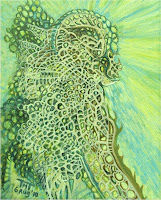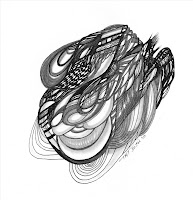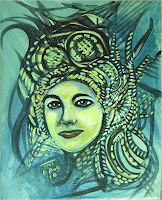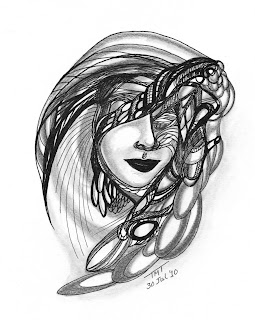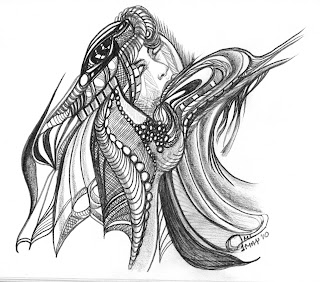| Washed out colour, curving depth of field, poor image quality. Photo from 2004 with Vivitar 3MB digital. |
You'd think this wouldn't be too hard! But it's taken me years of fiddling around with this that and the other to get closer and closer to what I wanted to achieve here...
I figured I was the perfect person to do this... I'd started in photography in my teens and I'd worked in a photography store when I was seventeen, and I had gotten my first SLR camera for my sixteenth birthday! I wasn't an expert, but I had a lot of background, I was a good problem solver and smart enough to have completed a degree in Electrical Engineering, so why not? (Famous last words!)
I started out on this particular project in 1996 with a regular SLR (single lens reflex) because that gave the best quality. Unfortunately, you didn't get to see the final result until you got your film developed, so there was a time lag and the mistakes could get expensive. In those days, you couldn't get a digital copy of your photos when you went in to get them developed. so you ended up scanning the finished prints, which introduced a bit of degradation in itself!
The image on the right is something I don't have anymore, so basically, that poor image is all I have left. Sad, sad, sad!
I was one of the people that waited impatiently for digital cameras to come down in price so I could afford one. The time lag was something I really hated! I'd forget the settings for each shot and end up wasting a lot of time and effort on images that I would have deleted if I'd seen right away how they had turned out.
My first digital camera in 2004 was a Vivitar 3Megapixel, which I paid over three hundred bucks for! You can get something much better now for under a hundred... Sigh.
Mind you, at that point in time, Digital SLR's were way out of my price range... So it was better than where I was in some ways, (but it wasn't an SLR so the image quality definitely suffered.) but I still wasn't getting anywhere near what I wanted.
| Same pieces shot in 2010 with DSLR. |
| Artwork shot in 2004 with Vivitar 3MB Digital. |
As you can see by the shot on the left, the colour was hard to get close to the real colour quality, it was affected by ambient light in a major way, and whatever compensation it was doing on it's own wasn't helping.
I mean, am I alone in this, but are camera manuals actually written to be confusing? Often, I would find it would take a long time to get an answer to a simple question out a manual, and the internet was even worse!
I mean, eventually, I had gotten the hang of the basics, for anyone that is interested, here are the basic steps to taking digital images of art with a digital SLR (recommended, but you can do this with regular digital cameras as well.
a) Choose the highest Megapixel setting,
b) turn off the flash,
c) set the ISO to 100 and
d) the aperture to at least F8, setting the camera on aperture priority,
e) choose a fast shutter speed,
f) white balance the camera,
g) and shoot outside with a tripod.
b) turn off the flash,
c) set the ISO to 100 and
d) the aperture to at least F8, setting the camera on aperture priority,
e) choose a fast shutter speed,
f) white balance the camera,
g) and shoot outside with a tripod.
| Shot outside, with DSLR. White balance is off. |
The artwork has to be straight, with the camera planes and the artwork planes equal to each other, or you will get fuzziness at the edges of your image. You also need to make sure you give border around the piece so that your focal plane can be cropped out. What I mean by that, is that unless you use a macro lens, which gives a flat focal plane, your image will slightly curve at the outer edges, which will blur the artwork image if you extend the piece right the edge of the picture frame.
But for me, that wasn't enough, I wanted to take my pictures inside, which meant lights!
Now lights, that's a whole other problem... My artwork is varnished, so you always get glare when you use a flash.
And it really doesn't matter if you photograph the paintings unvarnished, you still get glare! This was an issue I had been dealing with right back to my days with my old SLR, and it wasn't getting resolved to my satisfaction.
Now lights, that's a whole other problem... My artwork is varnished, so you always get glare when you use a flash.
And it really doesn't matter if you photograph the paintings unvarnished, you still get glare! This was an issue I had been dealing with right back to my days with my old SLR, and it wasn't getting resolved to my satisfaction.
After I got the DSLR, I could get good enough shots, but not really as I wanted to get closer, and control the lighting more closely. I tried a number of solutions: flash diffusers, those little puffers, and hot, stand alone lights... I even made a makeshift diffuser for in front of the studio lights I used to have out west, and it sort of did the job. But it wasn't perfect.
| DSLR with window backlight from morning sun and Macro lens. |
Then I added in the issue of photographing glass paintings, just to make it more interesting, and that just got me back into the old problem of finding the perfect photography solution to the regular artwork... Which I had started to ignore, actually...
Once I bought a secondhand macro lens for my DSLR, the glass painting issue was solved (finally!) as the flat plane of focus and extra sharp detail certainly satisfied me.
Since I didn't want to take photos of the glass paintings at night (I needed the backlighting from the sun to catch them properly), I was back to my initial quest of photographing my regular paintings indoors with artificial light. I'm not an outdoors person or a morning person, so this was important to me!
It's the little things that count though, and I finally got some help on this, a photo store clerk named Scotty (I kid you not Star Trek fans!), helped me for two hours today figuring out a solution for my problem. What I am trying to do is called 'copy image' photography, and it's usually done by professional photographers. But not all of them know how to do it.
You need to put two light sources pointed at your piece at 45 degree angles and the two light sources and your camera need to be in the same plane. IE: on the same level, same height. Or else your light with be concentrated higher or lower depending on where you are taking the picture from.
You need to put two light sources pointed at your piece at 45 degree angles and the two light sources and your camera need to be in the same plane. IE: on the same level, same height. Or else your light with be concentrated higher or lower depending on where you are taking the picture from.
You can get this effect with regular lights with umbrellas, strobe lights with umbrellas, or slaved flashes. You can umbrella the flashes as well if you just really like umbrellas!
If you use flashes, you don't have to worry about the ambient light from other sources, just adjusting for the light introduced by the flashes. Synchronization is important as well... It's not an easy problem, but we resolved it by going with the wireless functionality on my Pentax KX which allows me to use two specific flashes on the same channel so that they go at once and all the focussing and the rest of the digital handshaking works properly. I'm putting the flashes on tripods so that I can get them at the same height as my camera and fixes to the best height for the piece I'm photographing.
If I was using fixed floods with diffusers or umbrellas, I'd have to adjust to ambient light and it would also get hot. The flashes give off enough light when they go that the ambient light is flooded out by the sheer intensity of the light from the flashes. Not the case with the fixed lights. Otherwise, they'd really be hot! Ambient light could introduce blues (daylight), ambers (tungsten lights), other blues (fluorescents), and if it hits at the wrong angle, you can cause uneven lighting on the artwork or even glare.
If you use flashes, you don't have to worry about the ambient light from other sources, just adjusting for the light introduced by the flashes. Synchronization is important as well... It's not an easy problem, but we resolved it by going with the wireless functionality on my Pentax KX which allows me to use two specific flashes on the same channel so that they go at once and all the focussing and the rest of the digital handshaking works properly. I'm putting the flashes on tripods so that I can get them at the same height as my camera and fixes to the best height for the piece I'm photographing.
If I was using fixed floods with diffusers or umbrellas, I'd have to adjust to ambient light and it would also get hot. The flashes give off enough light when they go that the ambient light is flooded out by the sheer intensity of the light from the flashes. Not the case with the fixed lights. Otherwise, they'd really be hot! Ambient light could introduce blues (daylight), ambers (tungsten lights), other blues (fluorescents), and if it hits at the wrong angle, you can cause uneven lighting on the artwork or even glare.
Anyway, I think I've finally gotten close enough to satisfy myself on image colour reproduction, sharpness, (right to the edges!), depth of colour and no glare. I guess I can go back to painting!
Images by Teresa Young:
1. Dragon Feed - Jun.2010, 2. Untitled Surreal - 1996, 3.and 4. Alien Rotations - Apr.2010, 5. Jubilee - Jan.2002, 6. Frozen Frame - Aug.2010, 7. Exposing Your Inner Child - Aug.2010.
Images by Teresa Young:
1. Dragon Feed - Jun.2010, 2. Untitled Surreal - 1996, 3.and 4. Alien Rotations - Apr.2010, 5. Jubilee - Jan.2002, 6. Frozen Frame - Aug.2010, 7. Exposing Your Inner Child - Aug.2010.
 |
| Exposing Your Inner Child |


























